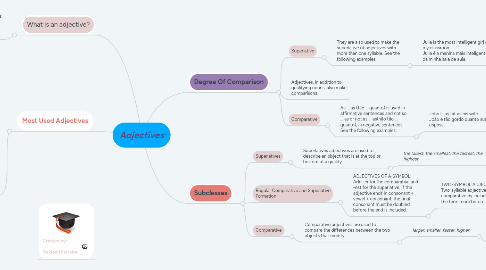
1. What is an adjective?
1.1. Is Every Word That Characterizes The Noun, Indicating Quality, Defect, Condition, Condition, etc.
2. Subclasses
2.1. Superlatives
2.1.1. Superlatives adjectives are used to describe an object that is at the top or bottom of a quality
2.1.1.1. the tallest, the smallest, the fastest, the highest
2.1.1.1.1. They are used in sentences in which the subject is registered in a group of objects.
2.2. Regular Comparative and Superlative Formation
2.2.1. ADJECTIVES OF A SYMBOL: Add -er for the comparative and -est for the superlative. If the adjective ends in consonant + vowel + consonant, the final consonant must be doubled before the end is included.
2.2.1.1. TWO-SYMBOL ADJECTIVES: Two-syllable adjectives can form the comparative by including -er or by using the term more before the adjective.
2.3. Comparative
2.3.1. Comparative adjectives are used to compare the differences between the two objects that modify
2.3.1.1. larger, smaller, faster, higher
2.3.1.1.1. They are used in sentences in which two nouns are compared, as follows:
3. Degree Of Comparison
3.1. Superlative
3.1.1. They are also used to make the superlative of adjectives with more than one syllable. See the following examples:
3.1.1.1. Julia is the most intelligent girl of my classroom. Julia é a menina mais inteligente da minha sala de aula.
3.1.1.1.1. Adjectives that have a syllable and those that are syllable ending in -le, -ow and -er form the comparative with the addition of -er to the normal degree and of -est to form the superlative.
3.2. Adjectives, in addition to qualifying nouns, also make comparisons
3.3. Comparative
3.3.1. As ... as (tão ... quanto) is used in affirmative sentences and not so ... as or not as ... as(não tão ... quanto), in negative sentences. See the following examples:
3.3.1.1. John is as fat as his wife. João é tão gordo quanto sua esposa.
3.3.1.1.1. The as + adjective + as structure is used in several crystallized expressions in English.
